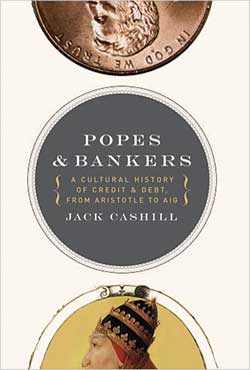Obamacare Scheming Smells of Jekyll Island
Jack Cashill
WorldNetDaily.com - march 18, 2010
In my new book, “Popes and Bankers,” I tell the story of how one hundred years ago this November, six faux duck hunters gathered on a small private island off the coast of Georgia.
The stealthy, incremental way in which the group plotted big government’s future set something of a blueprint for a century to come, one that Obama, Pelosi, Reid et al. have followed almost to the letter.
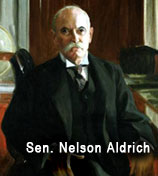 For at least four of the six, the descent to Georgia was draped in mystery. Each guest was instructed to show up at Hoboken Station and there board the private railroad car, blinds drawn, of Senator Nelson Aldrich.
For at least four of the six, the descent to Georgia was draped in mystery. Each guest was instructed to show up at Hoboken Station and there board the private railroad car, blinds drawn, of Senator Nelson Aldrich.
Aldrich, they knew, was John D. Rockefeller’s man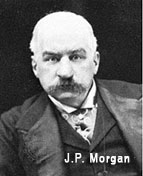 in the U.S. Senate. He and Henry Pomeroy Davison, a senior partner in the House of Morgan, would accompany them on the journey to a destination that had been secured by J. Pierpont Morgan himself.
in the U.S. Senate. He and Henry Pomeroy Davison, a senior partner in the House of Morgan, would accompany them on the journey to a destination that had been secured by J. Pierpont Morgan himself.
At Brunswick, Georgia, the six men boarded a boat headed for Jekyll Island, a hunting retreat for the elite described by one magazine as “the richest, the most exclusive and most inaccessible club in the world.”
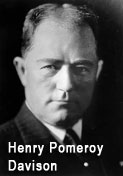 For the next ten days, the six men and a small, skeleton staff had the island to themselves. They emerged at retreat’s end with what came to be known as the “Aldrich Plan,” a document that, with a few modifications, would soon enough reshape the world of finance.
For the next ten days, the six men and a small, skeleton staff had the island to themselves. They emerged at retreat’s end with what came to be known as the “Aldrich Plan,” a document that, with a few modifications, would soon enough reshape the world of finance.
For the record, the duck hunters owed their invitation to the Panic in 1907 and the man who calmed it. That crisis had found Morgan at the peak of his powers.
Now more than 70 years-old, he caused Wall Street and Washington to wonder what would happen in a future emergency if there were no Morgan among them.
“Something has got to be done,” Senator Aldrich worried out loud. “We may not always have Pierpont Morgan with us to meet a crisis.”
Even before the panic, academia had been quietly militating for a solution to future crises that did not involve Morgan or any other independent agent.
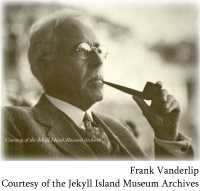 The academics saw central control along scientific principles as a solution to a free and competitive market. At a Columbia University conference in1907, one Frank Vanderlip argued that a competitive, decentralized banking system caused the panic, “one of the great calamities in history.”
The academics saw central control along scientific principles as a solution to a free and competitive market. At a Columbia University conference in1907, one Frank Vanderlip argued that a competitive, decentralized banking system caused the panic, “one of the great calamities in history.”
His outspokenness on this issue earned him a round trip to Jekyll Island. Following Vanderlip at Columbia was Paul Warburg, a 34 year-old partner in the investment banking house of his in-laws, Kuhn, Loeb & Company.
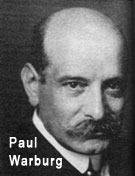 “Small banks constitute a danger,” he told those gathered at Columbia in arguing for the benefits of European-style banking.
“Small banks constitute a danger,” he told those gathered at Columbia in arguing for the benefits of European-style banking.
Warburg, in fact, had a problem with the whole idea of a free, self-regulating market. He hoped to replace Adam Smith’s “invisible hand” with the “best judgment of experts,” himself high among them. In 1910, Warburg too took up duck hunting on Jekyll Island.
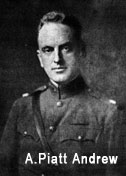 A. Piatt Andrew and Benjamin Strong donned their hunter togs as well. Indiana born, Andrew had been educated at Princeton and in the inevitable Europe and had taught economics at Harvard. Then the president of Banker’s Trust Company, the 39 year-old Strong owed his career to Davison and to Davison’s boss, Morgan.
A. Piatt Andrew and Benjamin Strong donned their hunter togs as well. Indiana born, Andrew had been educated at Princeton and in the inevitable Europe and had taught economics at Harvard. Then the president of Banker’s Trust Company, the 39 year-old Strong owed his career to Davison and to Davison’s boss, Morgan.
Strong and Davison were the two Morgan men in attendance. Aldrich and Vanderlip were Rockefeller men. Warburg represented Kuhn, Loeb, and Andrew, an economist, was friendly to all camps.
The only duck or wild turkey the men saw during the ten-day retreat was on their dinner plates. Before leaving, they took a pledge of secrecy. It would be four years before anyone got wind of the meeting and twenty years before any of the men admitted being there.
Given the secrecy and the seriousness of the enterprise, the swamps of Jekyll Island would serve as the primordial stew for a thousand conspiracy theories, some of which are close to accurate.
Strong and Vanderlip drafted the document, initially called the Aldrich Plan, which summarized the strategy agreed upon at the retreat. The plan called for the creation of a “National Reserve Association,” a sort of banker’s cooperative that replicated the function of a central bank without calling it such.
The association would have the authority to issue currency and lend to commercial banks. Although government appointees would sit on the association’s board, the bankers themselves would control it.
Aldrich had recommended a straightforward central bank on the European model, but the non-politicians knew better than he that a central bank could be more readily sold to the public if packaged as a decentralized bank.
Sound familiar?
The marketing campaign for the Aldrich Plan kicked off at a National Board of Trade meeting in January 1911. After a rousing speech in its favor by Andrew, delegates voted to back the plan.
The group’s chairman then appointed a seven-person committee to market the plan, headed by none other than Warburg. The delegates, of course, had no knowledge that Andrew and Warburg had helped draft the document they were about to promote.
To give the illusion of a grass roots effort, the committee of seven launched a National Citizens League for the Creation of a Sound Banking System and headquartered it in Chicago rather than New York.
To win over Congress, supporters of the plan would have to lose the “Aldrich” name and find a Democratic sponsor. Happily for them, Carter Glass, the head of the Banking Committee in the House, stepped up to champion the cause in the House.
The House Democrats and now President Wilson insisted on changes. They demanded not only the appearance of decentralization, but also at least a smidgen of reality.
There would be twelve private regional reserve banks in the system, and these would be placed under central political control. A Washington board, which included the Treasury secretary and presidential appointees, would oversee the whole system.
President Wilson looked upon this hybrid concoction and smiled. On December 23, 1913, eight months after the death of John Pierpont Morgan, he signed the Federal Reserve Act into law.
The Jekyll Island men smiled too, and they knew what they were smiling about. In analyzing the beast, they had figured out that the control of the system could very well reside with the presidency of the Federal Reserve Bank of New York if that first president were shrewd and resourceful.
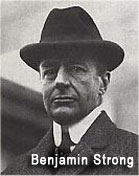 They had just the man in mind. From 1914 until his death in 1928 their own Benjamin Strong would preside over the New York Federal Reserve and set the monetary policy for the nation.
They had just the man in mind. From 1914 until his death in 1928 their own Benjamin Strong would preside over the New York Federal Reserve and set the monetary policy for the nation.
The Federal Reserve Act had not reduced the power of the duck hunters and their backers. It had merely reduced their responsibility.

(For more information on the birth of the Fed, see Jack Cashill’s new book, "Popes and Bankers").

